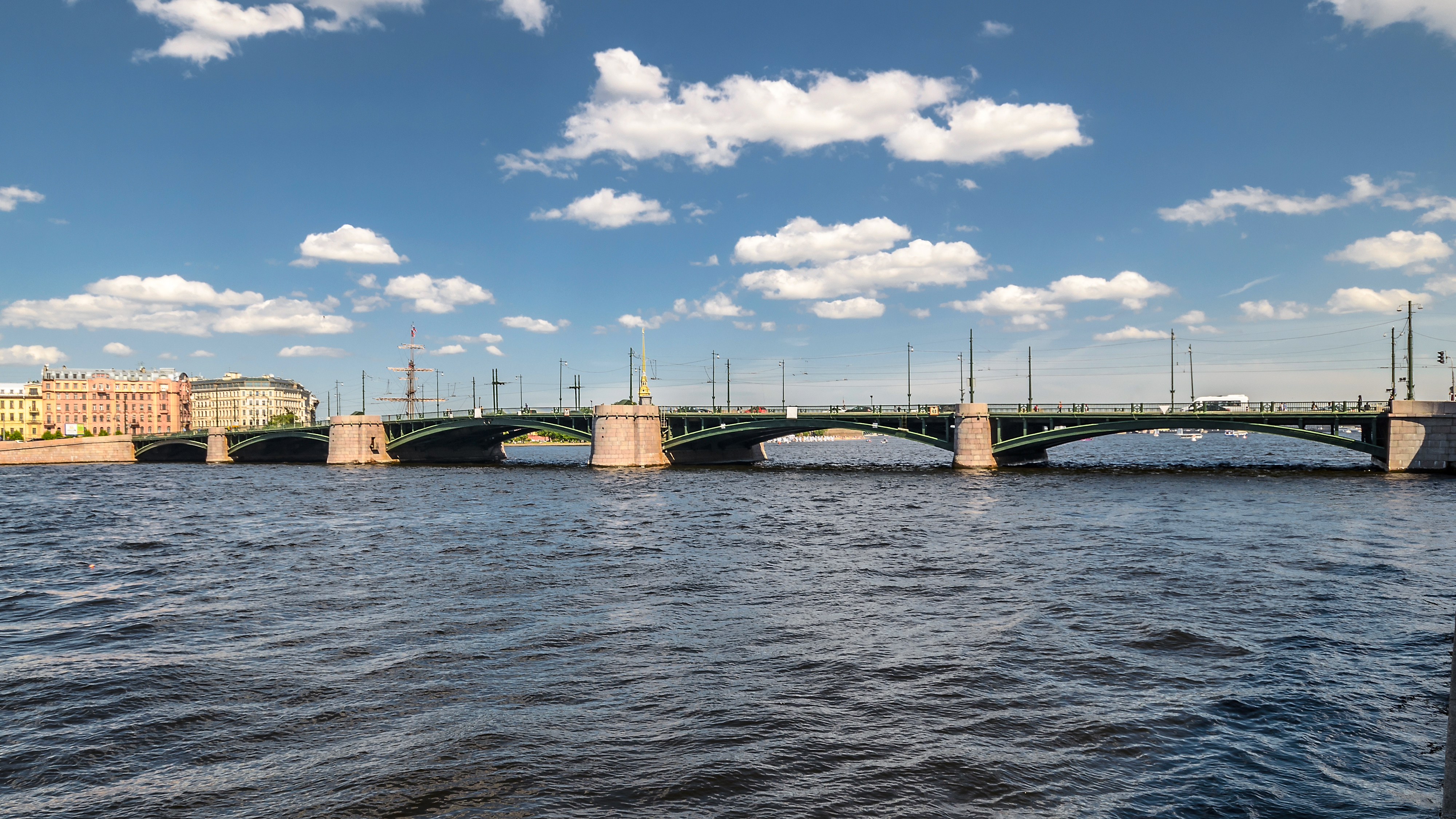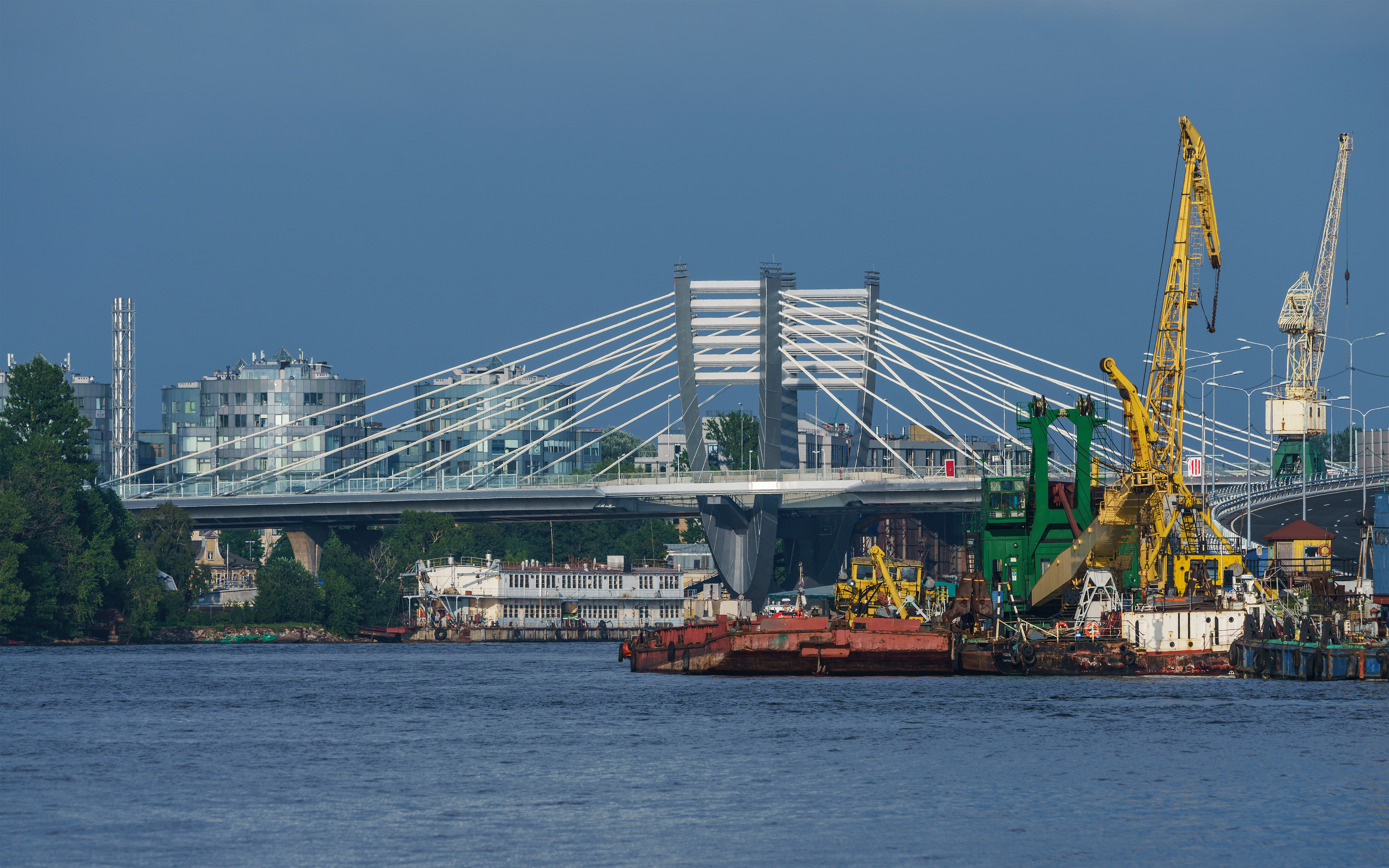|
Malaya Neva
The Little Neva or Malaya Neva (russian: Ма́лая Нева́) is the second largest distributary of the river Neva. The Neva splits into Great Neva (the southern armlet) and Little Neva (the northern armlet) near the Spit of Vasilievsky Island (easternmost tip of the island), in the historic centre of the city of Saint Petersburg. The Little Neva is long; the width is from , and the depth is . It has its own armlets: Smolenka and Zhdanovka. There are three bridges across Little Neva: Exchange Bridge, Tuchkov Bridge and Betancourt Bridge. See also * List of bridges in Saint Petersburg There are more than 342 bridges in the city limits of Saint Petersburg, Russia. This is a partial list of the most famous ones. Peter the Great was designing the city as another Amsterdam and Venice, with canals instead of streets and citizens sk ... References Rivers of Saint Petersburg Distributaries of the Neva {{Russia-river-stub ... [...More Info...] [...Related Items...] OR: [Wikipedia] [Google] [Baidu] |
Distributary
A distributary, or a distributary channel, is a stream that branches off and flows away from a main stream channel. Distributaries are a common feature of river deltas. The phenomenon is known as river bifurcation. The opposite of a distributary is a tributary, which flows ''towards'' and joins another stream. Distributaries are often found where a stream approaches a lake or an ocean. They can also occur inland, on alluvial fans, or where a tributary stream bifurcates as it nears its confluence with a larger stream. In some cases, a minor distributary can divert so much water from the main channel that it can later become the main route. Related terms Common terms to name individual river distributaries in English-speaking countries are ''arm'' and ''channel''. These terms may refer to a distributary that does not rejoin the channel from which it has branched (e.g., the North, Middle, and South Arms of the Fraser River, or the West Channel of the Mackenzie River), or to one ... [...More Info...] [...Related Items...] OR: [Wikipedia] [Google] [Baidu] |
Neva
The Neva (russian: Нева́, ) is a river in northwestern Russia flowing from Lake Ladoga through the western part of Leningrad Oblast (historical region of Ingria) to the Neva Bay of the Gulf of Finland. Despite its modest length of , it is the fourth-largest river in Europe in terms of average discharge (after the Volga, the Danube and the Rhine). The Neva is the only river flowing from Lake Ladoga. It flows through the city of Saint Petersburg, the three smaller towns of Shlisselburg, Kirovsk and Otradnoye, and dozens of settlements. It is navigable throughout and is part of the Volga–Baltic Waterway and White Sea–Baltic Canal. It is the site of many major historical events, including the Battle of the Neva in 1240 which gave Alexander Nevsky his name, the founding of Saint Petersburg in 1703, and the Siege of Leningrad by the German army during World War II. The river played a vital role in trade between Byzantium and Scandinavia. Etymology The earli ... [...More Info...] [...Related Items...] OR: [Wikipedia] [Google] [Baidu] |
Great Neva
The Great Neva or Bolshaya Neva () is the largest armlet of the river Neva. It starts near the Spit of Vasilievsky Island (easternmost tip of the island). The Great Neva is long; the width is from and the depth up to . Its tributaries are Fontanka, Moyka and Novo-Admiralteysky Canal. There are two bridges across Great Neva: Palace Bridge and Blagoveshchensky Bridge The Annunciation Bridge ( - ''Blagoveshchensky most''; from 1855 to 1918 Nikolaevsky Bridge, ; from 1918 to 2007 called Lieutenant Schmidt Bridge, ) is the first permanent bridge built across the Neva River in Saint Petersburg, Russia. It conn .... References Rivers of Saint Petersburg Distributaries of the Neva {{Russia-river-stub ... [...More Info...] [...Related Items...] OR: [Wikipedia] [Google] [Baidu] |
Old Saint Petersburg Stock Exchange And Rostral Columns
The Old Saint Petersburg Stock Exchange (also '' Bourse'') and Rostral Columns, located in Saint Petersburg in the Russian Federation, are significant examples of Greek Revival architecture. Designed by French architect Thomas de Thomon, and inspired by the Greek Temple of Hera at Paestum, the stock exchange was constructed between 1805 and 1810. The rostral columns erected on either side of the Stock Exchange were completed in 1811. The Old Saint Petersburg Stock Exchange is located at Birzhevaya Ploschad 4. Old Stock Exchange Old Saint Petersburg Stock Exchange ( rus, Здание Биржи, r=Zdanie Birzhi) is an historic building in Saint Petersburg, the former location of the city's stock exchange. It is the main building in an architectural complex located on the spit of Vasilyevsky Island. The building, which is situated at Birzhevaya Ploschad 4, is an important example of Greek Revival architecture. Designed by French architect Thomas de Thomon and inspired by the Gre ... [...More Info...] [...Related Items...] OR: [Wikipedia] [Google] [Baidu] |
Vasilievsky Island
Vasilyevsky Island (russian: Васи́льевский о́стров, Vasilyevsky Ostrov, V.O.) is an island in St. Petersburg, Russia, bordered by the Bolshaya Neva and Malaya Neva Rivers (in the delta of the Neva River) in the south and northeast, and by Neva Bay of the Gulf of Finland in the west. Vasilyevsky Island is separated from Dekabristov Island by the Smolenka River. Together they form the territory of Vasileostrovsky District, an administrative division of Saint Petersburg. Situated just across the river from the Winter Palace, it constitutes a large portion of the city's historic center. Two of the most famous St. Petersburg bridges, Palace Bridge and Blagoveshchensky Bridge, connect it with the mainland to the south. The Exchange Bridge and Tuchkov Bridge across the Malaya Neva connect it with Petrogradsky Island. Vasilyevsky Island is served by Vasileostrovskaya and Primorskaya stations of Saint Petersburg Metro ( Line 3 ). There are pl ... [...More Info...] [...Related Items...] OR: [Wikipedia] [Google] [Baidu] |
Saint Petersburg
Saint Petersburg ( rus, links=no, Санкт-Петербург, a=Ru-Sankt Peterburg Leningrad Petrograd Piter.ogg, r=Sankt-Peterburg, p=ˈsankt pʲɪtʲɪrˈburk), formerly known as Petrograd (1914–1924) and later Leningrad (1924–1991), is the second-largest city in Russia. It is situated on the Neva River, at the head of the Gulf of Finland on the Baltic Sea, with a population of roughly 5.4 million residents. Saint Petersburg is the fourth-most populous city in Europe after Istanbul, Moscow and London, the most populous city on the Baltic Sea, and the world's northernmost city of more than 1 million residents. As Russia's Imperial capital, and a historically strategic port, it is governed as a federal city. The city was founded by Tsar Peter the Great on 27 May 1703 on the site of a captured Swedish fortress, and was named after apostle Saint Peter. In Russia, Saint Petersburg is historically and culturally associated wi ... [...More Info...] [...Related Items...] OR: [Wikipedia] [Google] [Baidu] |
Smolenka (river)
The Smolenka (russian: Смоленка) is a minor river in the city of Saint Petersburg, Russia. It is one of the armlets of the Neva forming its delta. It branches off the Malaya Neva armlet at , and flows through the Smolensky Cemetery into the Gulf of Finland, separating Decembrists' Island from the Vasilievsky Island Vasilyevsky Island (russian: Васи́льевский о́стров, Vasilyevsky Ostrov, V.O.) is an island in St. Petersburg, Russia, bordered by the Bolshaya Neva and Malaya Neva Rivers (in the delta of the Neva River) in the south .... It is long. The river takes its name from the Smolensky Cemetery. There are four bridges across the Smolenka: * Uralsky Bridge * Smolensky Bridge * Nalichny Bridge * Shipbuilders' Bridge Rivers of Saint Petersburg Distributaries of the Neva {{Russia-river-stub ... [...More Info...] [...Related Items...] OR: [Wikipedia] [Google] [Baidu] |
Zhdanovka
The Zhdanovka (russian: Ждановка) is a short river in the Neva river delta in Saint Petersburg, Russia. It separates Petrogradsky Island from Petrovsky Island. History In the 17th century, the river did not have a specific name; however, it was sometimes referred to the St. Nicholas river (named after the chapel of the nearby Church of the Assumption). The place was also called "''Mokrushi''" (russian: Мокруши) because the area is surrounded by wetlands. In the 19th century, construction began on the deserted island Petrovsky. The Zhdanov brothers, Ivan and Nicholas, where the first to be granted land on the island. The Zhdanovs lined the river banks of the Malaya Neva to the current Little Petrovsky Bridge. Here, the brothers built a chemical-pharmaceutical plant, which drew up the birch tar and wood vinegar. The Brother's development of the area led their name being used refer to the river and the street along it. On the left bank of the river, the Petrovsky pa ... [...More Info...] [...Related Items...] OR: [Wikipedia] [Google] [Baidu] |
Exchange Bridge
Exchange Bridge (russian: Биржево́й мост, ''Birzhevoy most'') is a bascule bridge in Saint Petersburg, opened in 1894. The bridge crosses the Little Neva River (distributary of Neva River) close to the Exchange Square and connects the Vasilyevsky and Petrogradsky islands. It takes its name from the Old Saint Petersburg Stock Exchange (also ''Bourse'', russian: Биржа) located nearby. The closest metro station is Sportivnaya. Timeline * 1894 - the original wooden bridge was built * 1922 - the bridge was renamed to ''Builders' Bridge'' * 1956 - major reconstruction * 1989 - the bridge was renamed back to ''Exchange Bridge'' See also * List of bridges in Saint Petersburg There are more than 342 bridges in the city limits of Saint Petersburg, Russia. This is a partial list of the most famous ones. Peter the Great was designing the city as another Amsterdam and Venice, with canals instead of streets and citizens s ... Sources St. Petersburg encyclope ... [...More Info...] [...Related Items...] OR: [Wikipedia] [Google] [Baidu] |
Tuchkov Bridge
Tuchkov Bridge (russian: Ту́чков мост) is a bascule bridge across Little Neva (a distributary of Neva river) in Saint Petersburg, Russia. Its length is 226 meters and its width is 36 meters. Tuchkov bridge connects Vasilievsky Island and Petrogradsky Island. History and present state The original bridge was built in 1758 in wood. It got its name after local businessman Avraam Tuchkov who financed its construction and who had warehouses nearby. The bridge has been reconstructed several times. Last time it was reconstructed in 1962-1965. Modern Tuchkov bridge has three spans, the middle one being a draw span. Unlike older bridges in St. Petersburg, the design of Tuchkov bridge lacks permanent decorations. In 2010s it is yearly decorated with electric lights to be seen from Birzhevoy Bridge for winter season. Tram service In the early years of 21st century this bridge was left as the only tram service link leading from Vassilievskiy Island. The remaining service (Rout ... [...More Info...] [...Related Items...] OR: [Wikipedia] [Google] [Baidu] |
Betancourt Bridge
Betancourt Bridge (russian: Мост Бетанку́ра, ''Most Betankura'') is a non- bascule 6-lane bridge with a cycle path in Saint Petersburg that opened in 2018. The bridge crosses the Little Neva and the Zhdanovka rivers, passing Petrovsky and , and connects the Vasilyevsky and Petrogradsky islands. The bridge is part of the , it allows non-stop traffic from Pulkovo Airport to the Krestovsky Stadium. First ideas to construct a bridge across appeared as early as in the 1980s. Since that time the design was changed significantly, instead of the straight lay the bridge became S-shaped in order to avoid the ‘Almaz’ military shipyard that was located on the bank of the Little Neva. However, the production was closed before the actual construction of the bridge even started. It is named in honor of Agustín de Betancourt, a prominent engineer of Spanish origin, who worked on many architectural structures in Saint Petersburg. The construction of the Betancourt bridge was ... [...More Info...] [...Related Items...] OR: [Wikipedia] [Google] [Baidu] |








